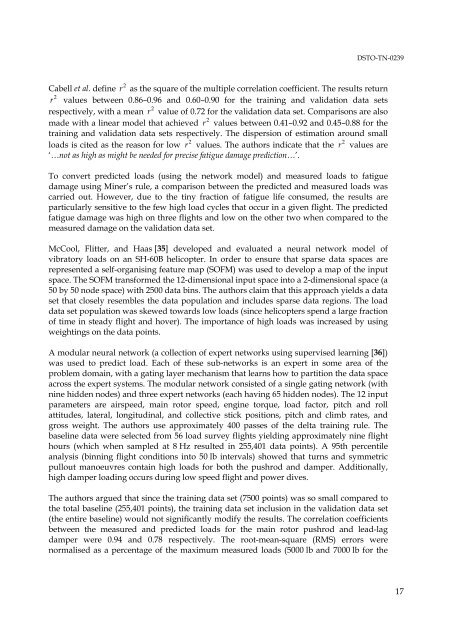Estimation of Structural Component Loads in Helicopters: A Review ...
Estimation of Structural Component Loads in Helicopters: A Review ...
Estimation of Structural Component Loads in Helicopters: A Review ...
You also want an ePaper? Increase the reach of your titles
YUMPU automatically turns print PDFs into web optimized ePapers that Google loves.
DSTO-TN-02392Cabell et al. def<strong>in</strong>e r as the square <strong>of</strong> the multiple correlation coefficient. The results return2r values between 0.86–0.96 and 0.60–0.90 for the tra<strong>in</strong><strong>in</strong>g and validation data sets2respectively, with a mean r value <strong>of</strong> 0.72 for the validation data set. Comparisons are alsomade with a l<strong>in</strong>ear model that achieved r 2 values between 0.41–0.92 and 0.45–0.88 for thetra<strong>in</strong><strong>in</strong>g and validation data sets respectively. The dispersion <strong>of</strong> estimation around smallloads is cited as the reason for low r 2 values. The authors <strong>in</strong>dicate that the r 2 values are‘…not as high as might be needed for precise fatigue damage prediction…’.To convert predicted loads (us<strong>in</strong>g the network model) and measured loads to fatiguedamage us<strong>in</strong>g M<strong>in</strong>er’s rule, a comparison between the predicted and measured loads wascarried out. However, due to the t<strong>in</strong>y fraction <strong>of</strong> fatigue life consumed, the results areparticularly sensitive to the few high load cycles that occur <strong>in</strong> a given flight. The predictedfatigue damage was high on three flights and low on the other two when compared to themeasured damage on the validation data set.McCool, Flitter, and Haas [35] developed and evaluated a neural network model <strong>of</strong>vibratory loads on an SH-60B helicopter. In order to ensure that sparse data spaces arerepresented a self-organis<strong>in</strong>g feature map (SOFM) was used to develop a map <strong>of</strong> the <strong>in</strong>putspace. The SOFM transformed the 12-dimensional <strong>in</strong>put space <strong>in</strong>to a 2-dimensional space (a50 by 50 node space) with 2500 data b<strong>in</strong>s. The authors claim that this approach yields a dataset that closely resembles the data population and <strong>in</strong>cludes sparse data regions. The loaddata set population was skewed towards low loads (s<strong>in</strong>ce helicopters spend a large fraction<strong>of</strong> time <strong>in</strong> steady flight and hover). The importance <strong>of</strong> high loads was <strong>in</strong>creased by us<strong>in</strong>gweight<strong>in</strong>gs on the data po<strong>in</strong>ts.A modular neural network (a collection <strong>of</strong> expert networks us<strong>in</strong>g supervised learn<strong>in</strong>g [36])was used to predict load. Each <strong>of</strong> these sub-networks is an expert <strong>in</strong> some area <strong>of</strong> theproblem doma<strong>in</strong>, with a gat<strong>in</strong>g layer mechanism that learns how to partition the data spaceacross the expert systems. The modular network consisted <strong>of</strong> a s<strong>in</strong>gle gat<strong>in</strong>g network (withn<strong>in</strong>e hidden nodes) and three expert networks (each hav<strong>in</strong>g 65 hidden nodes). The 12 <strong>in</strong>putparameters are airspeed, ma<strong>in</strong> rotor speed, eng<strong>in</strong>e torque, load factor, pitch and rollattitudes, lateral, longitud<strong>in</strong>al, and collective stick positions, pitch and climb rates, andgross weight. The authors use approximately 400 passes <strong>of</strong> the delta tra<strong>in</strong><strong>in</strong>g rule. Thebasel<strong>in</strong>e data were selected from 56 load survey flights yield<strong>in</strong>g approximately n<strong>in</strong>e flighthours (which when sampled at 8 Hz resulted <strong>in</strong> 255,401 data po<strong>in</strong>ts). A 95th percentileanalysis (b<strong>in</strong>n<strong>in</strong>g flight conditions <strong>in</strong>to 50 lb <strong>in</strong>tervals) showed that turns and symmetricpullout manoeuvres conta<strong>in</strong> high loads for both the pushrod and damper. Additionally,high damper load<strong>in</strong>g occurs dur<strong>in</strong>g low speed flight and power dives.The authors argued that s<strong>in</strong>ce the tra<strong>in</strong><strong>in</strong>g data set (7500 po<strong>in</strong>ts) was so small compared tothe total basel<strong>in</strong>e (255,401 po<strong>in</strong>ts), the tra<strong>in</strong><strong>in</strong>g data set <strong>in</strong>clusion <strong>in</strong> the validation data set(the entire basel<strong>in</strong>e) would not significantly modify the results. The correlation coefficientsbetween the measured and predicted loads for the ma<strong>in</strong> rotor pushrod and lead-lagdamper were 0.94 and 0.78 respectively. The root-mean-square (RMS) errors werenormalised as a percentage <strong>of</strong> the maximum measured loads (5000 lb and 7000 lb for the17
















